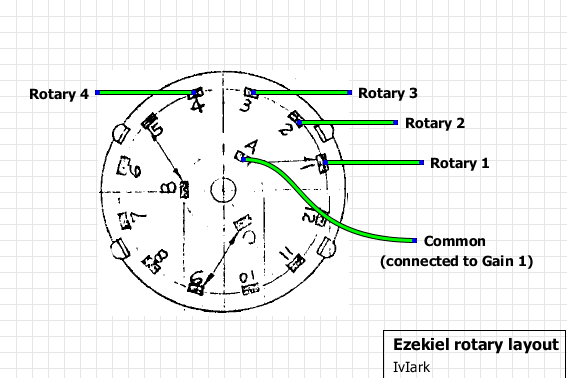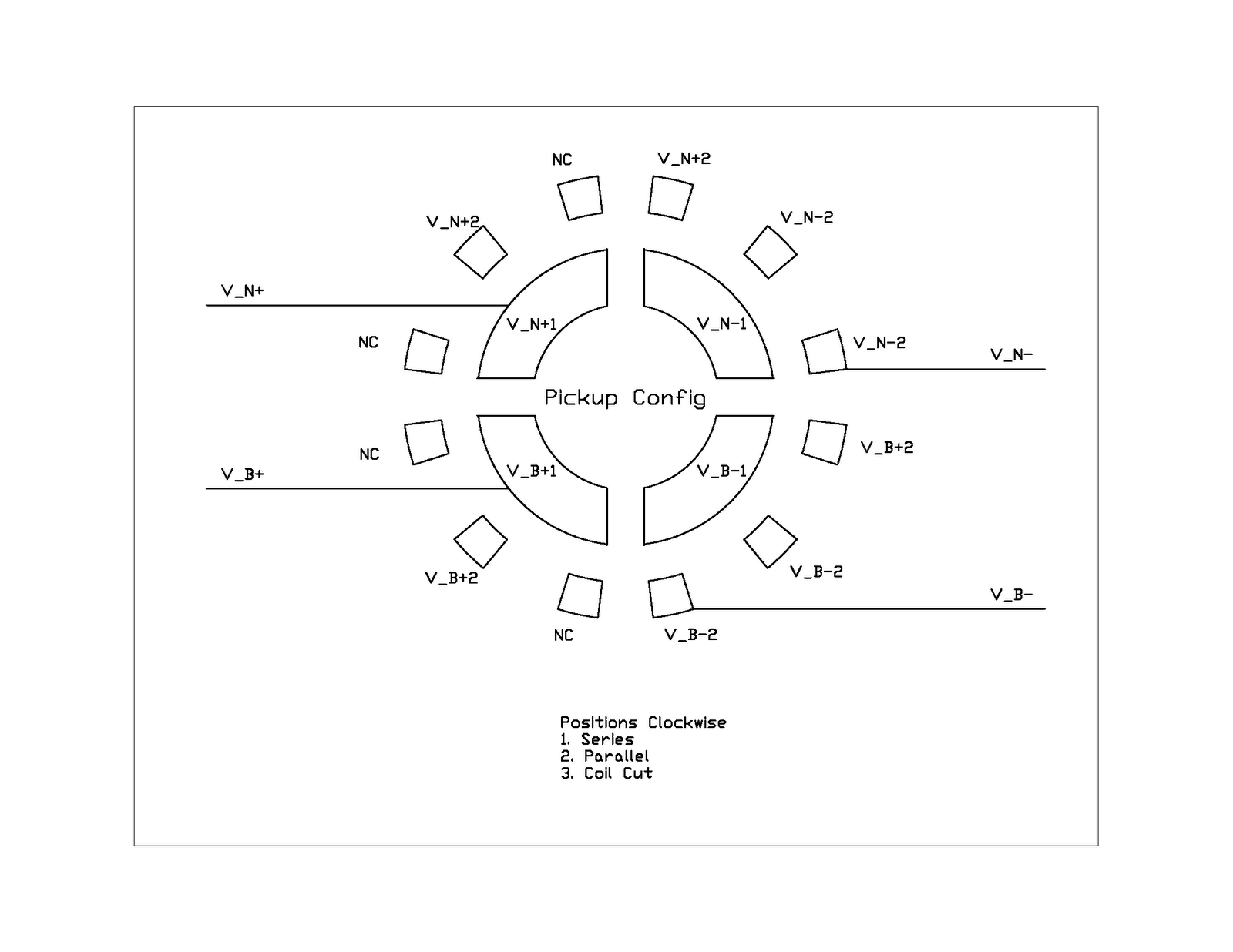DAM Ezekiel
|
This post was updated on .
I just built this and it works fine except for one unexpected thing:
 With the 3 position 4-pole switch I have it wired as shown, but if I keep turning the rotary I get the same diodes on each position, meaning A1, A5 and A9 all sound the same A2 A6 and A10 all sound the same A3 A7 and A11 all sound the same A4 A8 and A12 all sound the same It is as if A is hard wired to B & C. But when I tested one of the same switches with a continuity meter I only got continuity between A and 1,2,3,4, then B to 5,6,7,8 and then C to 9,10,11,12 (as I switched the rotary around of course). I thought I would be able to set up a three-way switch to A,B C and get 12 different combinations out of these rotary switches. Is that not right? 
|
|
Well...
I opened up one of these rotary switches and I see it has three wipers, like this: 1 2 3 4 5 6 7 8 9 10 11 12 A B C ^ ^ ^ SO, when you turn the rotary past 4, to 5, you have a new wiper but making the same connection (A to 1,2,3,4). I figure you can remove two of the wipers and connect A>B>C to make it a 12 position switch, but when you take it apart watch for ball bearings held in place by a spring; they give it the tight "snap" between positions. One of my ball-bearings went flying and I can't find it. I think the switch still works but it feels mushy and like it will fall apart soon. But I guess it worth the experiment. But there are also probably better ways to do this (like dip switches). |
|
This post was updated on .
I didn't have any issues with the rotaries I used to build Zekes (I've built 5 of them), but I used the same switches for all of them from the same ebay order.
I just tested lugs A and 1-4 on the DMM (to follow Mark's layout), and when the switch is fully counter clockwise, I get no load from A to 1 and overload on 2-4. Next position gives no load from A to 2 and overload on 1,3,4. Next is no load A to 3 and OL 1,2,4. Fully clockwise gives A to 4 and OL on 1-3. I don't think you get 12 combos but rather three sets of 4 combos. (There might be a way to wire up A, B, and C to get that, but I haven't worked it out...) The Zeke only uses 4. I think you could potentially use a 1P4T but maybe the 3P4T is used because it's cheaper/more common? That or DAM likes the extra mojo from the 3P4T. |
|
This post was updated on .
One more addition: If you really want 12 positions out of a 3p4t, you could throw a 1p3t switch in front of the rotary to toggle between A, B, and C. So the switch set to 1 would use rotary A and give you positions 1-4. Switch set to 2 would use rotary B and give you positions 5-8, Switch set to 3 would use rotary C and give you positions 9-12. Gain 1/Common on diagram would run into the 1p3t instead of directly to pole A on rotary.
Also, the "P" isn't "position" but rather "pole". The "T" is "throw" and is more like a "position". Think of a 3PDT stomp switch. Only 2 positions not 3 (the D means double). In the case of the 3P4T rotary, you get four throws, or four positions on the knob. Those 4 positions have 3 poles each... the B and C poles can be used to do another 2 links at each position. Ex: you could run voltage to lug B, and the Anodes of 4 different LEDs to 5-8 on the rotary. Then, you'd get an LED to light up for each of the four clipping sections. Then do something else with C like maybe changing the input cap for each clipping setting. Or instead of LEDs, run different input and output caps on B and C so each clipping section could have a different bass bleed. |
|
It is possible that mine were different than what you had. But I can say for certain that MY switches would not give you 12 different tones even with a 3-way switch up front. I was planning on trying that, but saw it wouldn't work.
This is what I ordered: http://www.taydaelectronics.com/rotary-switch-3-pole-4-position-alpha-sr2612f.html - these are "non-shorting" Maybe you had these: http://www.taydaelectronics.com/rotary-switch-3-pole-4-position-alpha-sr2511.html (shorting) I thought I could use a switch in front of the rotary to get 12 positions, but after I opened it I saw why I got repeating functions, and I could see that each group of four positions had its own "ring" - but that there were also THREE connecting wipers. In other words, once you get to position 5 the physical connection scheme repeats, so you really only get four different settings. I believe they are meant to be used with different components between positions, so as you go around you get different circuits - but that is not how the Ezekiel is designed. But I also see 1x12 rotaries at Jameco for $1.09. So, if I want 12 positions in the future I will just order those. |
|
Shorting should only affect how the switches behave during the switching action. Let's say you were switching from 1 to 2. With a shorting switch, A-2 is "on" before A-1 is turned "off". With a non-shorting switch, A-1 is "off" before A-2 is turned "on".
So with a shorting switch, two connections can be on at once. With a non-shorting, there exists a state where no connections are on. |
|
In reply to this post by motterpaul
 picture this with FOUR connecting wipers (between inner & out rings). That's similar to what I found inside my switch, so when you go around the connection scheme repeats. |
«
Return to Open Chat
|
1 view|%1 views
| Free forum by Nabble | Edit this page |

